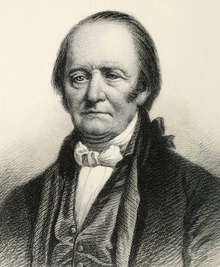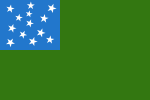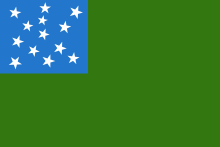Vermont Republic
| Official languages | English |
| Capital | Windsor , later Castleton |
| Administrative form | republic |
| governor |
Thomas Chittenden 1778–1789 Moses Robinson 1789–1790 |
| Existence period | 1777-1791 |

The term Vermont Republic was coined by later historians for the form of government from 1777 to 1791 that later became Vermont . In July 1777, partly in response to the Westminster Massacre , delegates from 28 towns came together and declared independence from the countries and land claims of the two British colonies and American states New Hampshire and New York.
history
After 1724, the Massachusetts Bay Colony built Fort Dummer near Brattleboro as well as three other forts along the northern part of the Connecticut River to protect themselves from Indian raids. After 1749, Benning Wentworth , the British governor of New Hampshire, gave land to everyone in a system of leases that enriched himself and his family. After the end of the French and Indian War , settlement activity there increased sharply. The province of New York also awarded land here, often overlapping with the grants by the New Hampshire Colony . This problem was raised by King George III. decided in 1764. He gave the land grant to New York, but this area is known as the New Hampshire Grants . The Green Mountain Boys , led by Ethan Allen , were a Vermont military unit that supported the claims of New Hampshire and fought against the British during the American Revolution .
When the Vermont Republic was established, slavery was abolished within the borders of the republic. Vermont residents considered themselves Americans. Due to violent objections from New York, which brought property claims to the New Hampshire Grants, the Continental Congress refused to recognize Vermont. The Haldimand Affair, Vermont's attempt at overtaking the British province of Quebec , failed in the late 1780s. In 1791 Vermont became the 14th state to join the United States, two years after the United States was established in its current form of government by its second constitution in 1789.
Vermont had no diplomatic connections, but had its own currency, the Vermont Copper, minted by the coin of Reuben Harmon in Rupert, and operated a postal system.
During the Vermont Copper the inscription: Vermontis. Res. Publica , the term State of Vermont was used in the Constitution and other official documents . This referred to the role of governor . In the constitution of 1777 for Vermont reference is made to both the "State of Vermont", as in the third paragraph of the preamble and in the last paragraph of the preamble the constitution refers to itself as the Constitution of the Commonwealth .
The Vermont Republic was also called the reluctant republic, as many of the early citizens would have preferred a union with the United States rather than independence. Both public opinion and the legal construction of the government of the independent Vermont Republic made it clear that the independent state of Vermont would join the original 13 states. When the Continental Congress for Vermont did not allow a seat, William Samuel Johnson , who represented Connecticut , was commissioned to stand up for the interests of Vermont. In 1785, Johnson was granted the rights to the former King's College Tract by the Vermont General Assembly as a kind of compensation for representing Vermont. The members of the 1787 congregation noted that Vermont was not yet separated from New York. However, James Madison's notes at the 1787 meeting made it clear that there was an agreement with New York that gave his approval for Vermont to join the Union. It was only a question of procedure, which depended on other, larger questions of the Union.
founding
After a dispute between the holders of the New York Grants and the New Hampshire Grants, Ethan Allen and his militia unit, the Green Mountain Boys, fought the Loyalists . On January 15, 1777, representatives of the cities in the area signed an agreement declaring the region independent. The region was called the Republic of New Connecticut , it is also known as the Republic of the Green Mountains . On June 2, 1777, the name was officially changed to Vermont , from the French les Verts Monts for the Green Mountains . The suggestion for this name came from Thomas Young , doctor and mentor to Ethan Allen. Young attended the Boston Tea Party as a patriot .
John Greenleaf Whittier's poem The Song of the Vermonters, 1779, describes this period. At first the poem was published anonymously. Since it bears a resemblance to the idiom of Ethan Allen's prose in the last stanza, it has been ascribed to Ethan Allen's prose for nearly 60 years. The last stanza reads:
“Come York or come Hampshire, come traitors or knaves,
If ye rule o'er our land ye shall rule o'er our graves;
Our vow is recorded — our banner unfurled,
In the name of Vermont we defy all the world! ”
"Come York or come Hampshire, come traitors or villains, if
you want to rule our country , you will rule our grave,
our vows recorded - our banner unfurled,
in the name of Vermont we defy the world!"
Constitution and Government
The Vermont constitution was drafted and ratified in 1777 in the Windsor Tavern of Elijah West in Windsor, Vermont , now the Old Constitution House . It was the first written constitution for an independent state in North America. The Vermont settlers who sought independence from the province of New York established their constitution on the same basis as the former colonies: all violence comes from the people. As historian Christian Fritz notes in American Sovereigns: The People and America's Constitutional Tradition before the Civil War :
“They saw themselves as a distinct region outside the legitimate jurisdiction of New York. Possessing an identifiable population or 'a people' entitled them to the same constitutional rights of self-government as other 'Peoples' in the American confederacy. "
“They saw themselves as a separate area outside of the legitimate province of New York. Having an identifiable population or 'citizen' entitled to the same constitutional rights of self-government as other 'citizens' in the American Confederation. "
In addition to establishing a new government for the original thirteen colonies, Vermont's claims to independence prompted the question of creating state governments. At the same time as they were fighting for independence from Britain, Americans had to wonder how this formation would take place and how the population could be involved.
The Vermont Constitution was drafted after the radical democratic constitution of Pennsylvania at the suggestion of Thomas Young, who worked with Thomas Paine and others on this document in Philadelphia in 1776 . The Vermont Constitution was the first to prohibit slavery and give all men the right to vote , regardless of property or possession.
After a British regiment of Allied Mohawk Indians attacked and terrorized the Vermont settlers along the White River during the Royalton Raid , one of the last Indian attacks in the American Revolutionary War , Ehtan Allen led a group of Vermont politicians in the Haldimand Affair with Frederick Haldimand , Talks to the Governor of the Province of Quebec (1763–1791) about the return to the British Empire. These talks ended in the Peace of Paris after the peace treaties , which ended the war of independence.
Although Vermont declared independence in 1777, it was not a member of the United States until 1791. This was due to border disputes with New York. Vermont agreed to pay 30,000 Spanish dollars to New York to settle the remaining land claims in the area.
Fourteen as a symbol
Much of Vermont's symbolism during this period is linked to a desire to be part of a political union with the United States. The Latin inscription Stella quarta decima was minted on the coins of Vermont between 1785 and 1786 . This means the fourteenth star . The Great Seal of Vermont , designed by Ira Allen , has a fourteen-branched jaw in the center.
union
As a result of an act by New York State on October 7, 1790, regarding a settlement to which New York City was claimed, the Vermont General Assembly authorized a convention to consider an application to join the Union of the United States. This congregation met in Bennington on January 6, 1791 . On January 10, 1791, the Assembly approved by 105 votes to 2 the motion for membership of the United States by resolution.
Vermont was admitted to the Union on March 4, 1791.
The Vermont Accession Act is the shortest of any state accession, and Vermont is the only state that has been approved without conditions of any kind, whether by Congress or the state from which they sprang. March 4th is celebrated as Vermont Day in Vermont .
Vermont's admission to the Union in 1791 as a free state counterbalanced the accession of Kentucky , which joined the United States as a slave state shortly after Vermont. The smaller states in the north were concerned about sea-to-sea grants still held by other states, and all states favored Vermont joining. Thomas Chittenden was governor of the Vermont Republic for most of its existence and the first governor of the state of Vermont after joining the United States.
The Vermont Constitution of 1793 had relatively few changes to the Vermont Constitution of 1777. It retained many of its original ideas. With a few changes, it has remained in force to this day.
Individual evidence
- ^ A b Frederic F. Van DeWater [1941]: The Reluctant Republic, Vermont 1724–1791 . The Countryman Press, 1974, ISBN 0-914378-02-3 , pp. 195, 218-219.
- ^ Peter S. Onuf: State-Making in Revolutionary America: Independent Vermont as a Case Study . In: Journal of American History . 67, No. 4, 1981, pp. 806-7.
- ^ SF Bemis: Relations between the Vermont Separatists and Great Britain, 1789-1791 . In: American Historical Review . 21, No. 3, 1916, pp. 547-560. doi : 10.1086 / ahr / 21.3.547 .
- ↑ http://www.manchestervermont.net/about.php ( Memento from April 18, 2011 on WebCite )
- ^ Vermont Office of the Secretary of State: The Constitution of 1777 . The Vermont State Archives & Records Administration. March 26, 2012. Archived from the original on July 25, 2012. Retrieved on May 18, 2012.
- ↑ Ira Allen [1798]: The Natural and Political History of Vermont . CE Tuttle Co, Rutland, VT 1969, ISBN 0-8048-0419-2 , p. 72.
- ^ Esther M. Swift: Vermont Place-Names, Footprints in History . The Stephen Greene Press, 1977, ISBN 0-8289-0291-7 , pp. 282-283.
- ^ Esther M. Swift: Vermont Place-Names, Footprints in History . The Stephen Greene Press, 1977, ISBN 0-8289-0291-7 , pp. 580, 587-588.
- ↑ Madison Debates: Tuesday August 29, 1787 . In: Avalon Project . Retrieved January 16, 2015.
- ↑ Frederic F. Van DeWater [1941]: The Reluctant Republic, Vermont 1724–1791 . The Countryman Press, 1974, ISBN 0-914378-02-3 , p. 182.
- ↑ Ira Allen [1798]: The Natural and Political History of Vermont . CE Tuttle Co, Rutland, VT 1969, ISBN 0-8048-0419-2 , p. 59.
- ^ Song of the Vermonters; the Ode Attributed to Ethan Allen. Its authorship finally settled - John G. Whittier acknowledges it as His, but Only as 'a Boy's Practical Joke'. . In: The New York Times , August 6, 1877. Retrieved April 2, 2008.
- ^ Peter S. Onuf: State-Making in Revolutionary America: Independent Vermont as a Case Study . In: Journal of American History . 67, No. 4, 1981, pp. 797-815.
- ^ Christian G. Fritz: American Sovereigns: The People and America's Constitutional Tradition Before the Civil War . Cambridge University Press, 2008, pp. 60-67.
- ^ Revolutionary War Timeline . Vermont Historical Society. Retrieved January 16, 2015.
- ^ Charles Spooner Forbes: Vermont's Admission to the Union . In: The Vermonter . 7, No. 8, March 1902, pp. 101-102. Retrieved January 25, 2011.
- ^ The Library of Congress, 1 Stat. 191 Retrieved January 6, 2014
- ^ Paul W. Gates, History of public land law development , p. 286. Public Land Law Review Commission, Washington DC 1968
- ↑ March 4 . In: History by Day . Archived from the original on April 5, 2011. Retrieved January 16, 2015.
- ↑ 1793 Vermont Constitution . Retrieved January 16, 2015.
literature
- Ira Allen [1798]: The Natural and Political History of the State of Vermont, One of the United States of America . Charles E. Tuttle Company, 1969, ISBN 0-8048-0419-2 .
- Michael A. Bellesiles: Revolutionary Outlaws: Ethan Allen and the Struggle for Independence on the Early American Frontier 1993.
- Frank Bryan, John McClaughry: The Vermont Papers: Recreating Democracy on a Human Scale . Chelsea Green Publishing, 1989, ISBN 0-930031-19-9 .
- J. Kevin Graffagnino: 'The Vermont' Story ': Continuity And Change In Vermont Historiography . In: Vermont History . 46, No. 2, 1978, pp. 77-99.
- Peter S. Onuf: State-Making in Revolutionary America: Independent Vermont as a Case Study . In: Journal of American History . 67, No. 4, March 1981, pp. 797-815.
- Vrest Orton: Personal Observations on the Republic of Vermont . Academy, 1981, ISBN 0-914960-30-X .
- Randolph A. Roth, The Democratic Dilemma: Religion, Reform, and the Social Order in the Connecticut River Valley of Vermont, 1791-1850 2003.
- Robert E. Shalhope: Bennington and the Green Mountain Boys: The Emergence of Liberal Democracy in Vermont, 1760-1850 1996. a standard scholarly history
- Frederic Franklyn Van de Water: The Reluctant Republic: Vermont 1724-1791 . The Countryman Press, 1974, ISBN 0-914378-02-3 .
- The Constitution of the State of Vermont: a Facsimile Copy of the 1777 Original . The Vermont Historical Society, 1977.
Web links
- Republic of Vermont in the Vermont Historical Society






